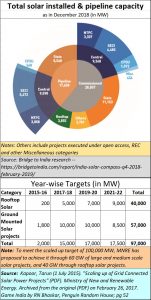https://www.freepressjournal.in/analysis/solar-power-shining-sun-fading-promises/1501865
Solar power: a story of missed opportunities
RN Bhaskar — April 11, 2019
In February 2019, Bridge to India published its report for the fourth quarter of 2018. The country’s total solar power generation capacity stood at 28.06 GW (see chart alongside). This included 3.86 GW for rooftop solar (https://bridgetoindia.com/report/india-solar-compass-q4-2018-february-2019/) .
 True the pipeline included another 17.66 GW that was under implementation as on December 31, 2018. But when both categories – installed and pipeline – are taken into account, the total still comes to 45.71 GW.
True the pipeline included another 17.66 GW that was under implementation as on December 31, 2018. But when both categories – installed and pipeline – are taken into account, the total still comes to 45.71 GW.
This is a far cry from the 100 GW that was supposed to be installed by the end of 2020. Yes, there are still 20 months to go before the deadline. But they will get swallowed up by the projects under implementation. It does appear that the country will see only half the targeted capacity being installed.
The situation is much worse when it comes to rooftop solar. Against a target of 40 GW (see chart), the government could achieve a target of just 3.86 GW – barely 10% of what was supposed to be done.
The slippage on the rooftop solar front is not hard to explain. The entire bureaucracy is worried about rooftop solar because it passes on the initiative from the government to the household. Once the installation is up and running, the government, and hence bureaucratic clout, become dispensable. The bureaucrat becomes almost redundant.
That could explain why the bureaucrat has been advising the government that it should go slow on rooftop solar. That could also explain why a safeguard duty of a crippling 25% has been slapped on solar modules being imported. In fact, someone should tell the ministers and the bean-counter experts that solar will help reduce oil imports. It will also reduce the use of firewood for cooking, thus saving on medical costs.
To see how the bureaucrat ill-advises the politician, one has only to look at two instances.
Take the recent Karnataka High Court judgement first. In March this year, the court quashed an order issued by the Karnataka Electricity Regulatory Commission (KERC) – normally manned by bureaucrats — relating to an increase in wheeling charges for open access power consumers in the state. It thus brought relief to all renewable energy generators trading power through open access in that state (https://mercomindia.com/karnataka-court-order-wheeling-open-access/).
The bureaucrat tells the minister that if private parties were to gain access to low-cost solar power (under Rs.6 a unit), they will not be able to compel businesses to pay the higher tariffs of Rs.8-12 per unit (kWh) of power consumed. That in turn will mean that the government will not be able to cross subsidise farmers – and power theft.
Instead the bureaucrats should know that there is a disruption coming in the power sector (see Tony Seba’s video (https://www.youtube.com/watch?v=2b3ttqYDwF0). They could have advised the minister of new ways to restructure the power business so that industry pays less and the remotest house gets uninterrupted power.
Take another example. Just a few months ago, the chief minister of Tripura had to go to Delhi to personally lobby with the power minister to allow his state to use rooftop solar for the remotest houses. The chief minister pointed out that supplying power to remote households by grid would be extremely expensive – over Rs.2 lakh per connection. Rooftop solar would cost less – just Rs.50,000 per installation (http://www.asiaconverge.com/2019/03/biplab-kumar-deb-has-big-plans-for-tripura/).
It would also have meant no further bills for the remote household. But the bureaucrats advised the power minister otherwise. The chief minister finally had to insist that the state would be willing to pay for the rooftop solar. That clinched the issue, and Tripura had its way. What the bureaucrats probably did not tell the minister was that the longer the transmission lines, the greater the power loss. And there is always the danger of theft – not only of the power, but of the wires and cables themselves.
Rooftop solar should have been a no-brainer in both the examples cited above. But bureaucrats love making even simple things complex. It appears that the bureaucrat, more than the legislator, has been responsible for the slippage on meeting solar power targets. That potential for derailing India’s strategic interests needs to be curbed.
Power policies need to change. Quickly.





































COMMENTS